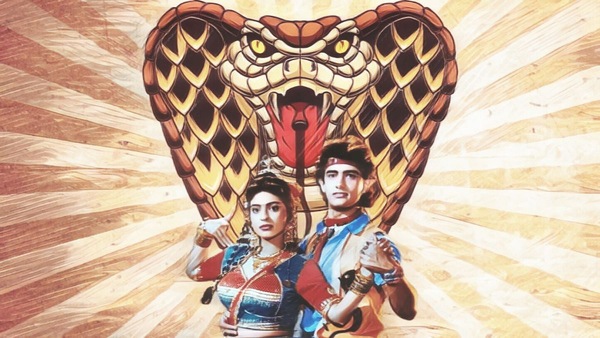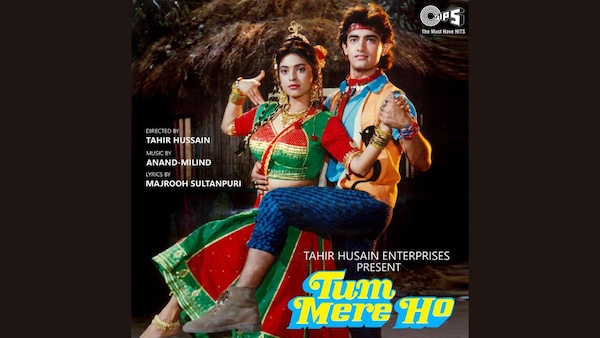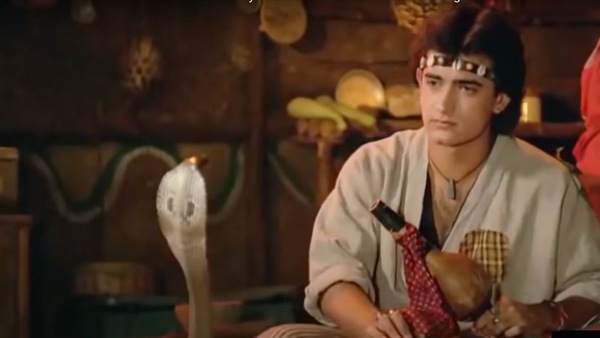When Bollywood's Shapeshifting Snake Genre Had An Unlikely Hero In Aamir Khan
Hollywood may have its zombies and werewolves. Bollywood had the ichhadhari nag or nagin. And Aamir Khan's Tum Mere Ho (1990) was a bizarre gem of the genre, writes Amborish Roychoudhury.

Juhi Chawla, Amir Khan in Tum Mere Ho
Last Updated: 12.39 PM, Aug 27, 2023
This column was originally published as part of our newsletter Stream Of Consciousness on August 27, 2023. Subscribe here. (We're awesome about not spamming your inbox!)
***
In #BizarreSpotlight, author Amborish Roychoudhury shines a light on overlooked Bollywood gems from his 'cabinet of curiosities'. Today: Aamir Khan-Juhi Chawla starrer Tum Mere Ho (1990).
AAMIR KHAN practically began his career with a National Award (for Raakh and Qayamat Se Qayamat Tak). Over the years, his name has been associated with some respectable films and with the tag “perfectionist”. It would then make a whole lot of sense that he once played a snake charmer with superpowers, one whose weapon of choice was a piece of human bone. His sidekick was a benign cobra called Nagraj, and together they went on some wild adventures, battling shape-shifting snakes and evil tantriks (exorcists). Two of his pet phrases from the film that would have gone down in history are “Kategi kya? (Are you going to bite me?)” and “Choos! (Suck!)” (Please get your mind out of the gutter. Neither of these means what you think it means. Gosh.)
Tum Mere Ho (1990) gave Aamir a chance to work with his father. His father Tahir Hussain was known for producing films such as Caravan (1971) and Anamika (1973). After two decades of being a producer, Tahir Hussain had decided to turn director, and who better to star in his directorial debut but his newly-minted superstar son? He even paired Aamir with Juhi Chawla. They had delivered a blockbuster in Qayamat Se Qayamat Tak, and the subsequent Love Love Love was not too bad either. What could go wrong? Every film needs to be about something, although most filmmakers in the late '80s didn’t have any such hangups. Amidst the array of songs, dances and action scenes, plots were an unnecessary distraction. For his film, Tahir chose the ‘Ichhadhari Naag’ genre.
Ichhadhari Nag/ Nagin comprises a time-honoured, widely popular genre in Indian cinema, comparable to the zombies and werewolves in Hollywood. While snake films have been in circulation right from the '50s, the idea of “ichhadhari” snakes who can shape-shift into humans is believed to have first successfully entered the realm of Bollywood through the 1976 film Nagin (Though superpowered reincarnating snake-lovers had been depicted in BR Ishara’s Milap four years earlier). Two serpents frolic in the park. A bunch of humans kill the male snake. Female snake avenges her boyfriend. Voila, you have a blockbuster on your hands. The audiences loved it and filmmakers latched on to it. Out popped titles like Nagin aur Suhagan, Naache Nagin Gali Gali, Naag Nagin, Doodh ka Karz, Sheshnaag, Naagmani and the biggies: Sridevi’s Nagina and Nigahen. It is to this illustrious tradition that Tum Mere Ho belongs.

A rich man — we’ll call him Chaudhary No. 1 — sees a baby snake protecting a precious stone, a Naag Mani. Overcome with greed, he kills the snake-child by dropping a bucket on it. The baby snake’s mom, the Naagin, appears in human form and smothers the bloodied dead snake with kisses. She vows to kill the man’s son in revenge. In the dead of the night, she creeps into his bedroom and bits the child. Chaudhary No. 1 places his son’s body in a cask and sets it afloat. A snake charmer finds the body and worried that this script is going nowhere, announces that the kid isn’t dead yet! He raises the kid, calls him Shiva and teaches him all the magic he knows, and he knows a bunch. Shiva, now Aamir Khan, is skilled at all kinds of sorcery. He wields what looks like a human shinbone, and chants mantras to control evil spirits and invoke spells. Shiva is a snake-wizard and he makes no bones about it.
He is often accompanied by his friend and loyal sidekick Nagraj the snake, and bumpkin Damroo (Raj Zutshi). There is a sublime triangle in the film where Damroo lusts after Bindiya, who in turns lusts after Shiva. This inspires some of the most memorable exchanges in the film. Damroo wonders aloud to Bindiya “Badan par ghee malkar aayi hai kya? Najar tere chehre par tikti hi nahi! (Have you smeared butter on your body? Can't fix my gaze at your face)” On the occasion of Nag Panchami, the “kabeela” engages in an elaborate mating ritual where the men are supposed to forcefully take the women away, and they are supposed to resist it, tooth and nail. If the man is successful, they are, well, married. How quaint. In one scene, Bindiya dares Shiva to take her on, to which he quips: “Kaategi kya? (Are you going to bite me?)” This is the kind of majestic writing that elevated Bollywood in the '90s.
Meanwhile, Paro (Juhi Chawla) spots Shiva play his been (a wind instrument known to “charm” snakes) and impressed by his dexterity, wastes no time in falling in love with him. They sing that chartbuster of a title song — 'Tum Mere Ho'. But Paro’s father is Chaudhary No. 2, another rich bloke, who will have nothing of this hanky-panky. He doesn’t want them to be together because of a secret only he and his wife are privy to. Since he doesn’t believe in employing goons, Chaudhary No. 2 sends a Tantrik named Kalunath (Anirudh Agarwal) to cripple Shiva. Shiva shuts his eyes, looks towards the heavens and wields his bone wand at the Tantrik. Kalunath has his backside handed to him. Poor thing has blood oozing from his eyes. At the urging of his adoptive father — the snake charmer who’s known only as Baba — Shiva lets Kalunath go.
This follows one of the most riveting scenes in the film. Baba scolds Shiva for sleeping around with a Chaudhary girl, and grounds him. Shiva is stuck inside the hut but longs to go out and canoodle with Paro. He jostles around the room in frustration, as Baba, Damroo and Bindiya sit on guard outside, laughing uncontrollably at his plight. But the kabeela has to go to a wedding and they leave. Shiva talks to Nagraj the snake, explaining to him just how much he loves Paro, Will he not help a friend in need? The serpent slithers out across the room, through the window, and hangs on to the latch of the door till it opens. This incredible feat is achieved on camera, and you want to hoot and whistle.

Paro’s mother tells her the secret they had been harbouring all along. As a baby, she had been married off, but her three-year-old husband was killed by a snake bite. At this point, marvelling at the Nolanesque twist, you realise that Paro’s father-in-law happens to be Chaudhary No. 1! The progressive Chaudhary family makes her live the life of a widow, until they decide to get her married to their shady nephew. In the final great reveal of the film, the Naagin (whose child was mauled by Chaudhary No. 1) re-appears and convinces everyone that Shiva is indeed the child she tried to kill, ergo he is the Chaudhary scion and Paro’s not-so-dead husband. Now that she has unfinished business with Shiva, she bites Paro in a bid to vanquish him. The Naagin (Kalpana Iyer) and Shiva engage in a duel. With the aid of his shinbone, Shiva defeats the Naagin and — get this — forces her to suck the venom from Paro’s leg. In a nailbiting sequence, Shiva thunders “Choos!” as the Naagin draws out all the venom, reviving Paro.
Tum Mere Ho is a bona fide classic and an underrated gem of Aamir Khan’s oeuvre. To paraphrase the great Morpheus, no one can be told what Tum Mere Ho is. It has to be seen to be believed.
Amborish Roychoudhury is the National Award-winning author of 'In a Cult of Their Own: Bollywood Beyond Box Office'. His latest book 'Sridevi: The South Years' was released on August 5, 2023.
